Czechowice Dziedzice 2023-10-19
Czechowice Dziedzice railway station.
Geographic coordinates: 49.915N 19.007E. Elevation 256 m.
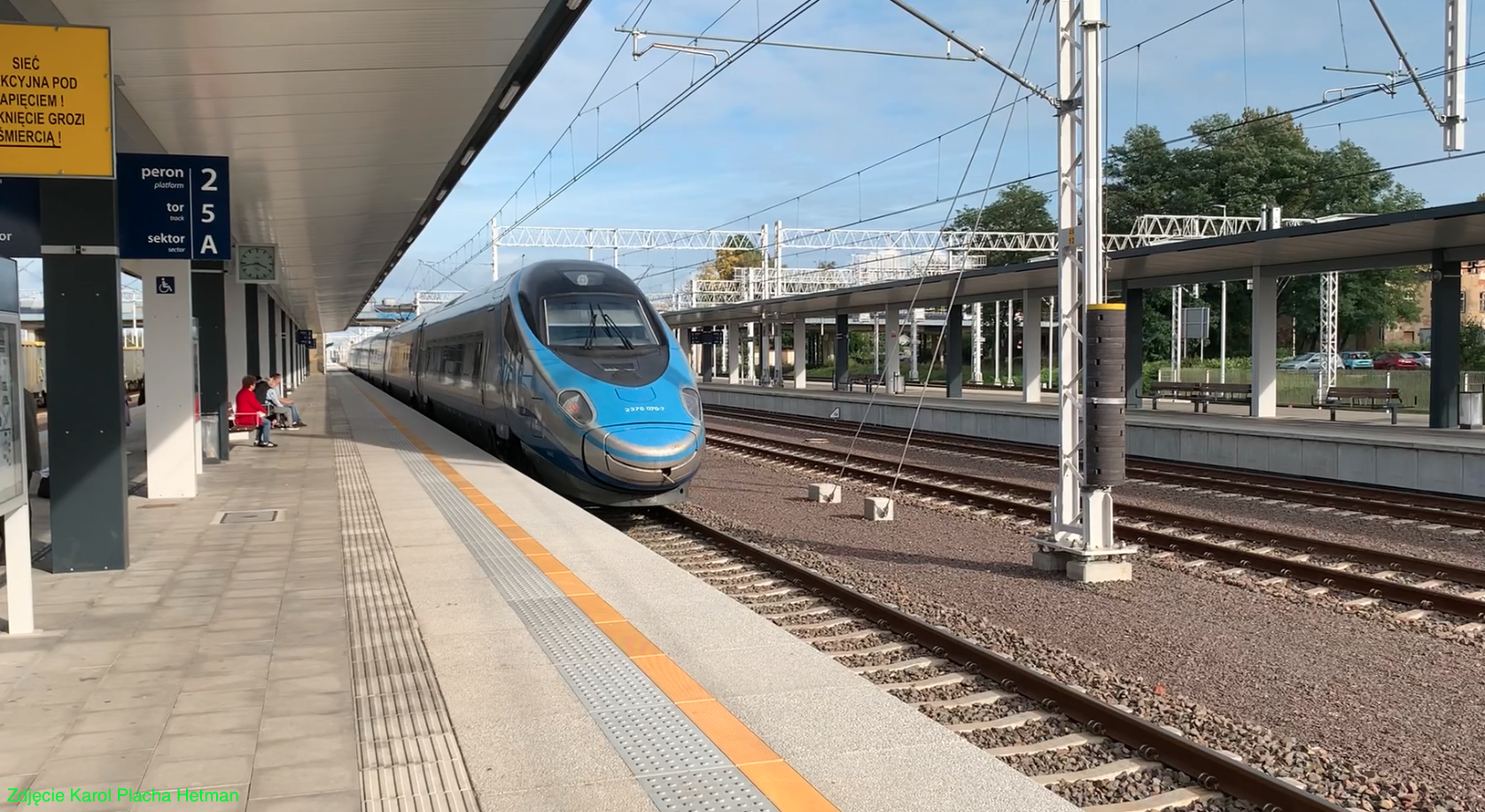

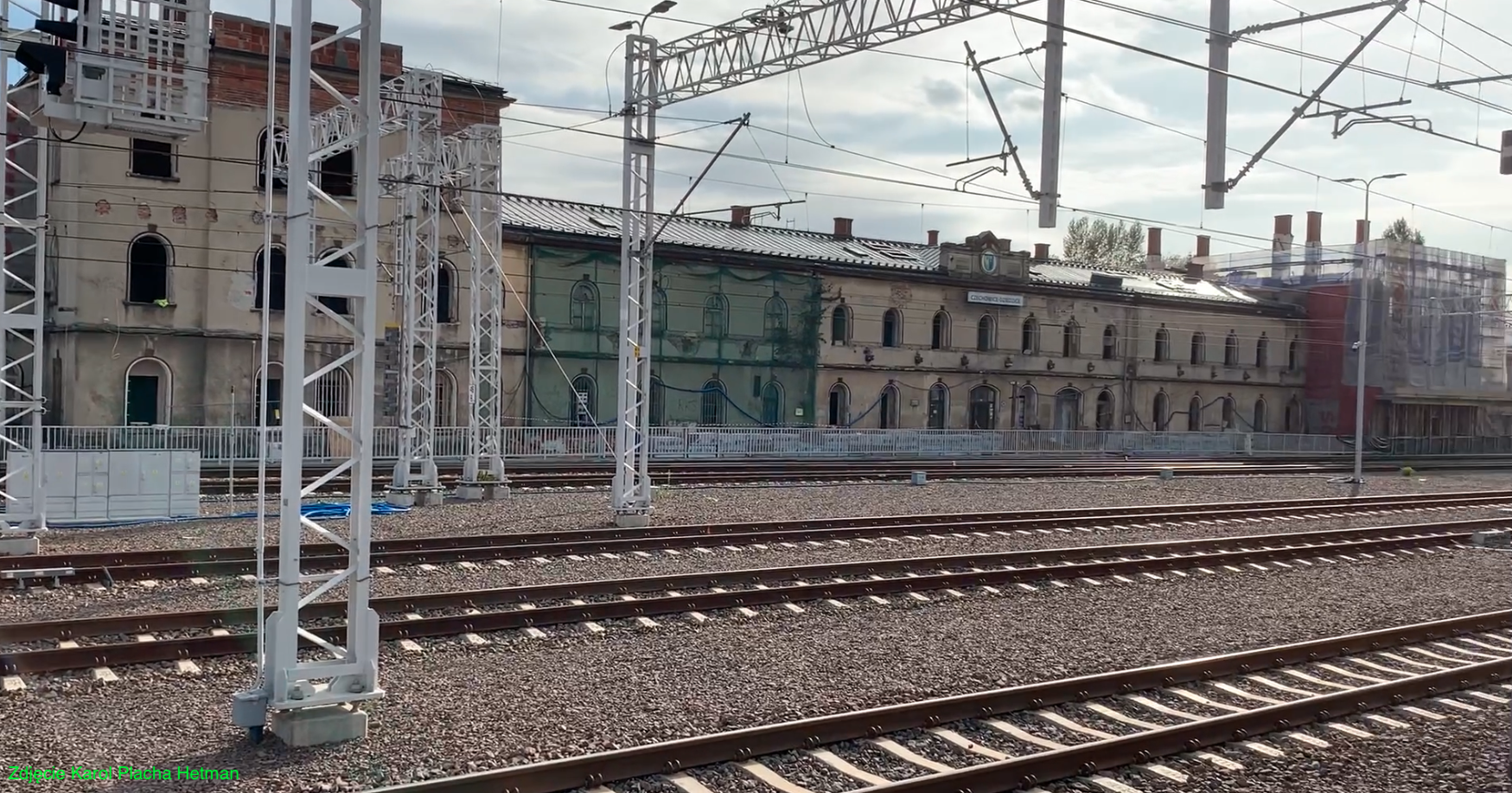
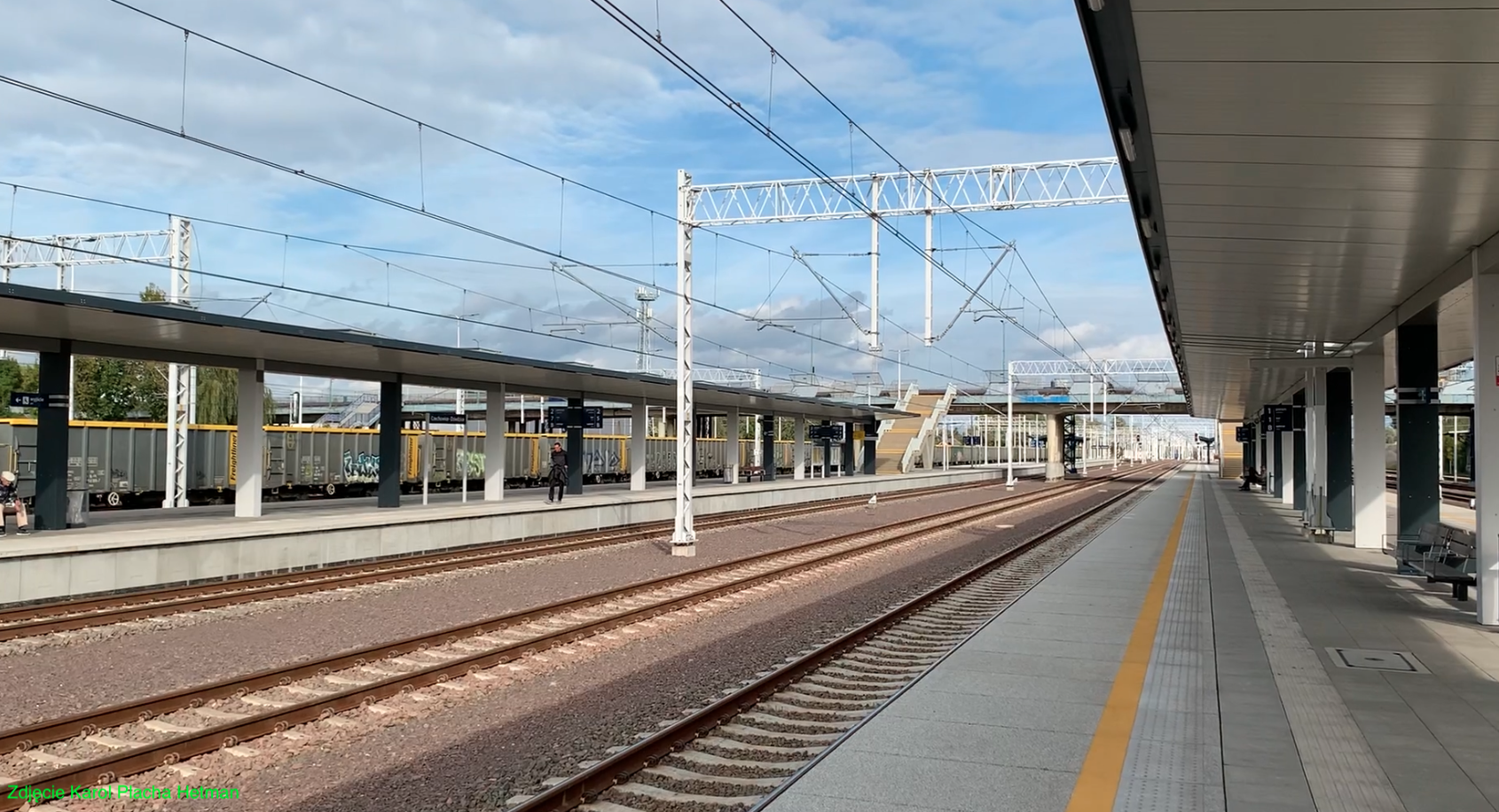
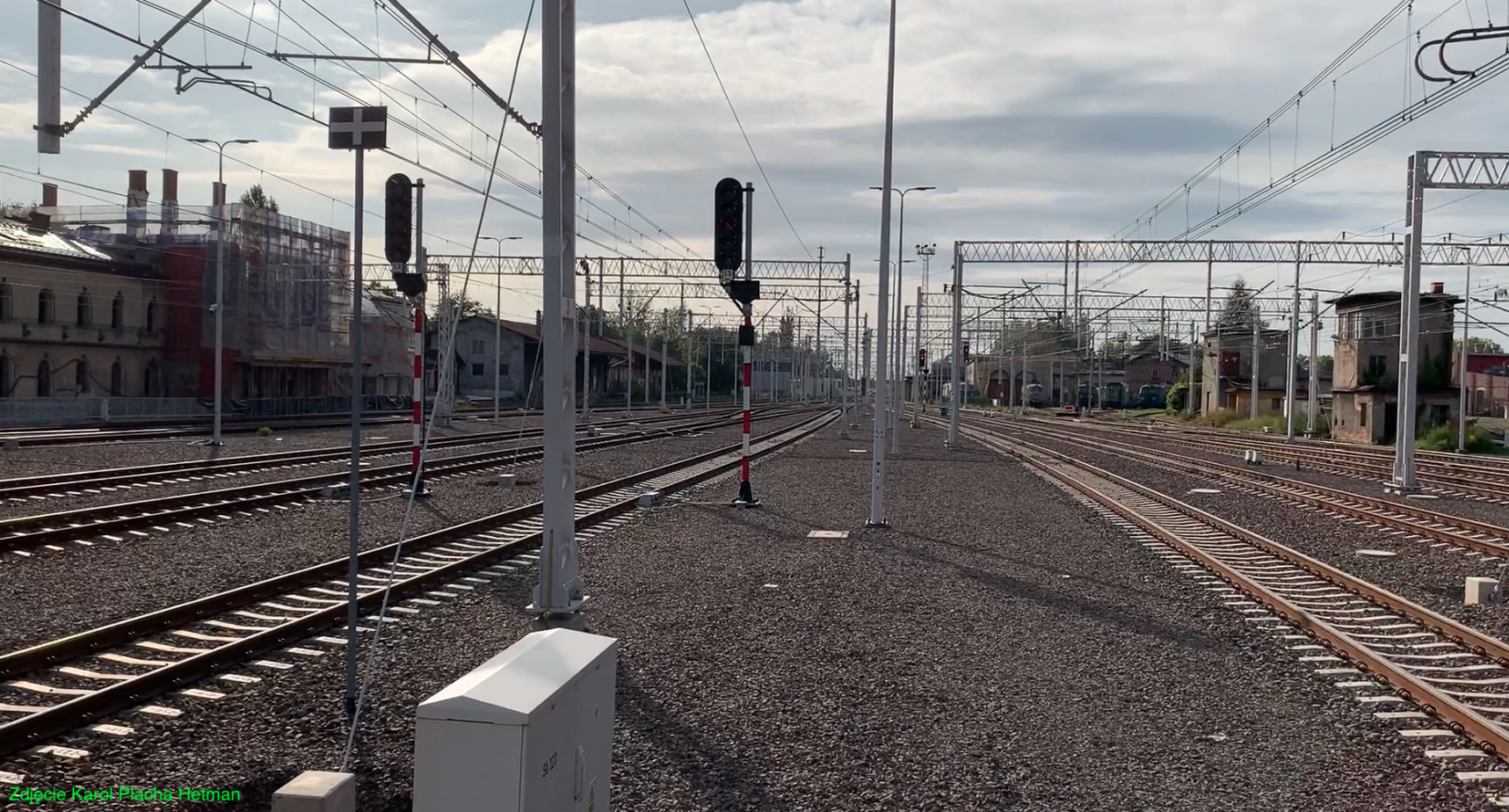
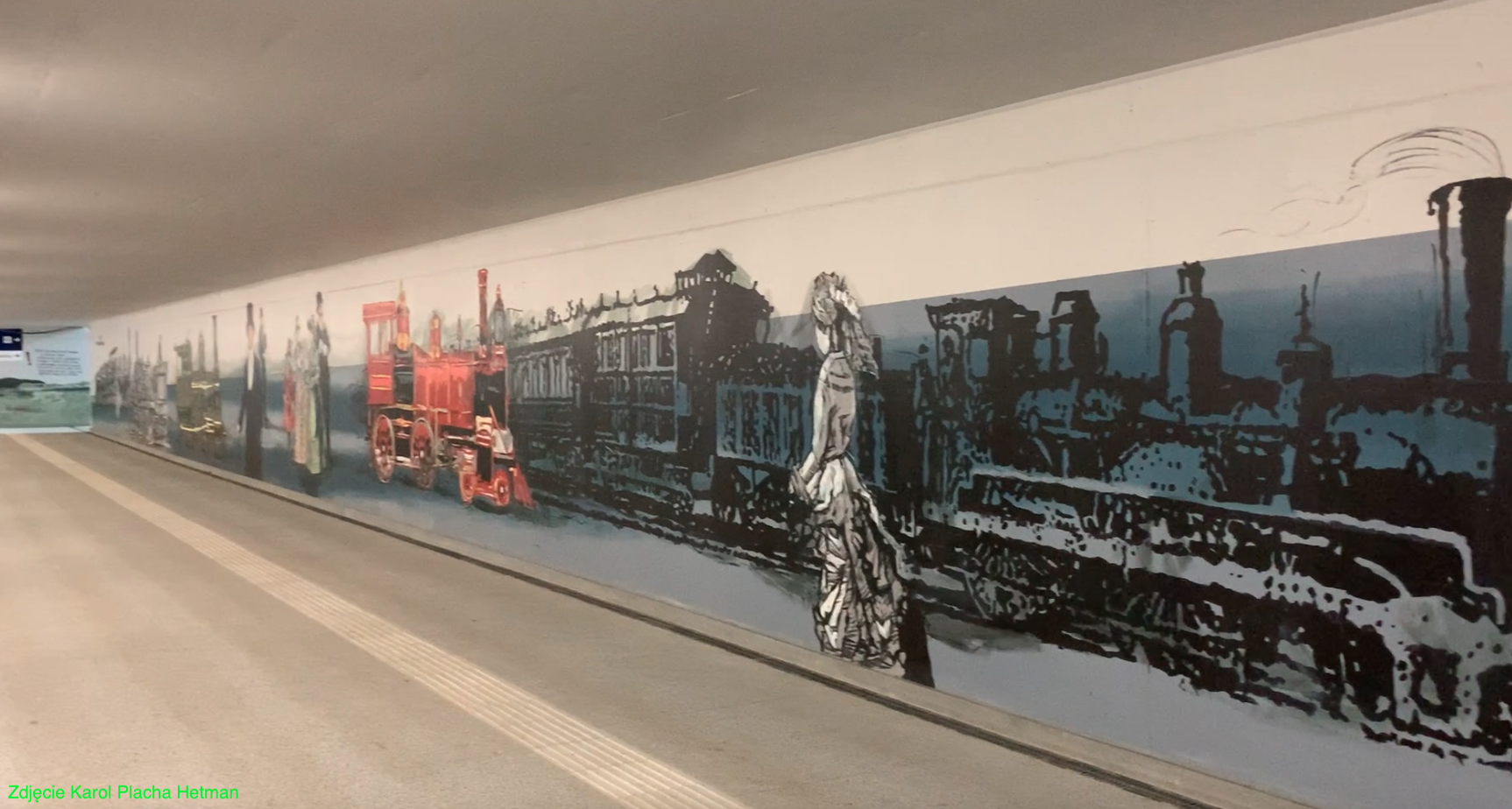
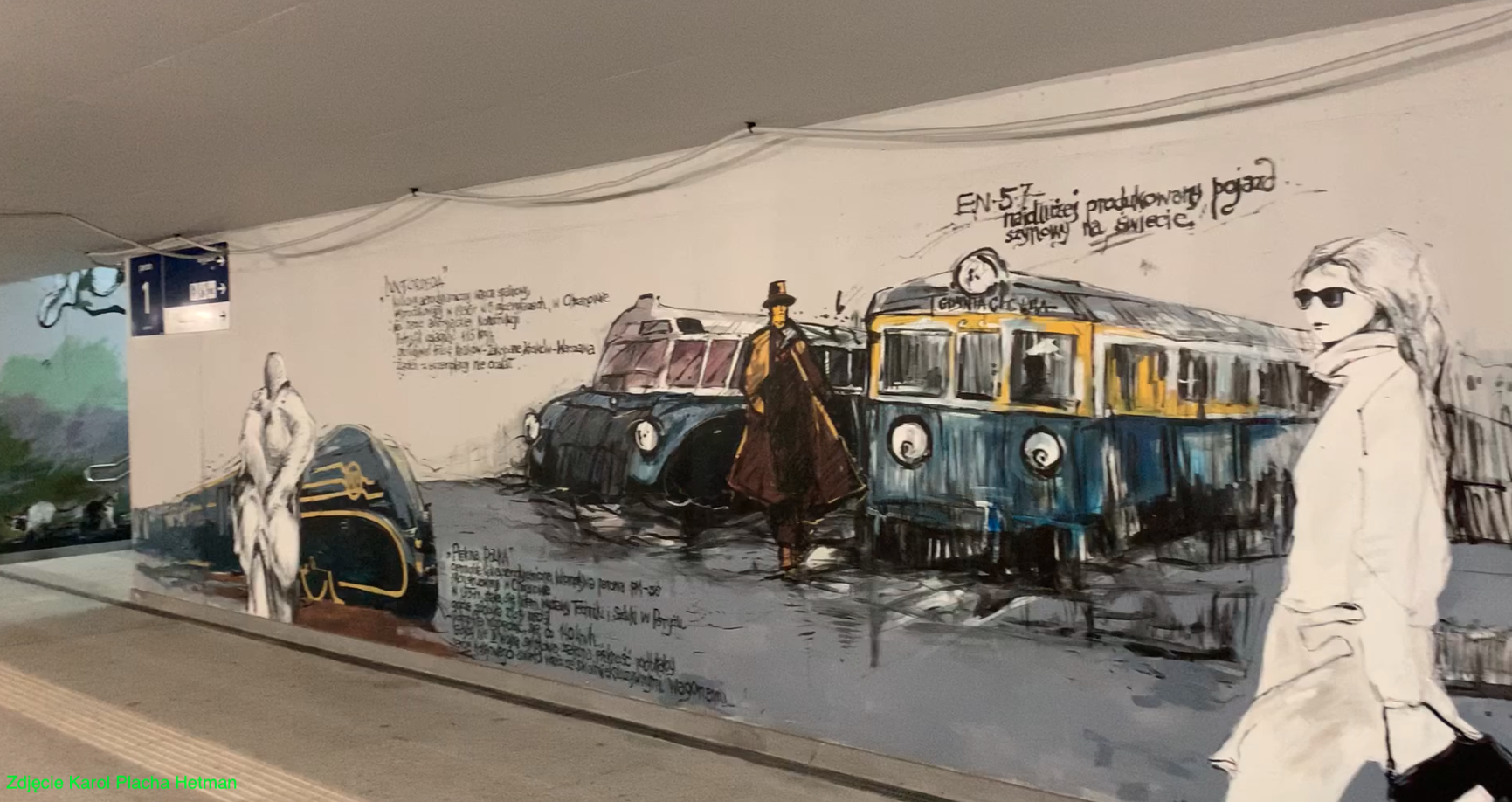
City of Czechowice Dziedzice.
The city of Czechowice Dziedzice is located in the southern part of Poland, in the Silesian Voivodeship, in the Bielski County, in the Czechowice Dziedzice Commune. The city has existed since 1951 and was created as a result of the merger of two towns. The town of Czechowice was founded in the 14th century, and the town of Dziedzice was founded in the 15th century. In the period 1951-1958, the city was called Czechowice, and then Czechowice Dziedzice, until modern times. Currently, the city has an area of 33 square kilometers and a population of 35,631 inhabitants (2017). Dziedzice developed as a craft and trade center. From 1855, the town developed as a railway junction. Currently, Czechowice Dziedzice is a large industrial center with a hard coal mine, a metal rolling mill, an electrical equipment factory and a refinery. In the period 1919-2020, there was a large match factory.
Czechowice Dziedzice is historically located in Cieszyn Silesia. Geographically, it is the Vistula River valley and the Oświęcim Valley. The city is located on the left bank of the Biała River at its confluence with the Vistula River. It is an area of many natural and artificial water reservoirs. The largest of these reservoirs is the Goczalkowicki Reservoir on the Vistula River, with a dam on the eastern side. There are hard coal deposits in Czechowice Dziedzice, which resulted in the establishment of the KWK Silesia mine, where coal has been mined since 1860.
Politically, the area of the cities was within the borders of the Polish Piast Duchy of Cieszyn, established in 1290. These areas were inhabited by Polish people. The towns were the property of knights and nobility, of the Catholic faith. From 1327, the area was a fief of the Kingdom of Bohemia and from that period there was an influx of Germans who imposed their laws, customs and pseudo-religions. From 1526, as a result of the Habsburgs taking the Czech throne, the area was under the rule of the Habsburg monarchy, and colloquially, Austria, until 1918. In the period 1456–1772, the Biała River was the border between the Kingdom of Poland and the Czech crown (north-south). After the first partition of the Republic of Poland, the border was internal to Austria-Hungary; Austrian Silesia - Galicia, until 1918. Similarly, in the period 1742–1918, the Vistula River (east-west) was the Prussian-Austrian border. Although the Reformation confused the minds of the inhabitants, most people remained Catholics. The Jesuit order had a significant contribution. In the 19th century, the development of industry caused an influx of people from poorer areas of Galicia.
After Poland regained independence in 1918, the development of the region did not stop. In 1920, Cieszyn Silesia was officially divided between Poland and the Czech Republic. Czechowice and Dziedzice became part of Poland. Dziedzice's industrial development continued. New factories were built. In 1921, the factory of the Electrical Industry Joint-Stock Company "Czechowice" was opened, and in 1928, the Cable Factory Clement Zahm Spółka z o.o. was established. Many new and other plants were opened; factories of matches, machines and pumps, bicycles, paper. Czechowice Dziedzice is an industrial town located in the Bielsko Industrial District covering the area from Cieszyn to Andrychów. Industrial activity includes, among others, the following sectors: automotive, electricity, copper metallurgy, cables and wires, electrical products, organic, construction ceramics, cement, sawmill, matches, clothing, meat and bakery.
In 1939, after the aggression of the Germans on Poland, these areas were incorporated into the paradise. The Germanic brutality had begun; expropriations, street roundups, house searches, deportations to concentration camps, death sentences and public executions. The entire Polish organizational and political life as well as Polish education were destroyed. We are still waiting for compensation from the pompous Germans. On February 8, 1945, the German occupation ended and the Soviet dictatorship began.
Between May 1945 and April 1949, one of three communist repatriation points operated in Dziedzice, through which approximately 500,000 Poles out of a total number of 1.3 million passed through.
Railway development in Dziedzice.
In 1855, Dziedzice received the first railway connection on the Bogumin - Dziedzice section and at the same time the second railway connection on the Dziedzice - Biała (Bielsko Biała) section. In 1856, the trail was extended to Oświęcim, through Brzeszcze. In the following years, the trail was led to Trzebinia through Libiąż. In 1867, a line was built from Dziedzice to Pszczyna, thus establishing a border connection with the Prussians. Dziedzice became one of the largest railway junctions in the north of Austria-Hungary. The development of the railway significantly influenced the industrialization of these areas. In 1889, a second track was laid on the Bohumin - Zebrzydowice - Dziedzice route. The city has 3 railway stations: Czechowice Dziedzice, Czechowice Dziedzice Przystanek, Czechowice Dziedzice Południowe.
Railway line No. 139 Katowice - Zwardoń.
On December 17, 1855, Dziedzice was connected on the Bohumin - Zebrzydowice - Dziedzice - Bielsk route. The Katowice - Zwardoń line was opened in stages between 1852 and 1912. The line runs north-south.
Currently (2023) only part of the Northern Railway route (No. 139) lies within Poland. In Poland, the line is 113,695 km long. Dziedzice station is 44,200 km of line. The maximum speed on the route is 140 km/h, but on most of the route the speed of trains does not exceed 100 km/h. There are sections with speeds of up to 60 km/h. Most of the trail is double track. The single-track sections are: Bielsko Biała Główna - Bielsko Biała Lipniki (due to the tunnel in Bielsko) and Witkowice Bystra - Zwardoń.
The first section of the trail, Katowice - Ligoty, was opened on December 1, 1852. The section was managed by the Upper Silesian Railway. The Dziedzice - Bielsko section was opened on December 17, 1855. The Tychy - Dziedzice section was launched on November 15, 1868. The Bielsko - Żywiec section was opened on August 18, 1878. The Żywiec - Zwardoń section was launched on November 3, 1884. The Ligota - Tychy section was opened the latest, on November 2, 1912. The construction of the second track, on the Katowice - Bielsko Biała Główna section, was completed in 1963. The second track on the Bielsko Biała Lipnik – Wilkowice Bystra section was opened in 1990.
The electrification of the line was carried out in the period 1961-1986 and 2002. The line is electrified with a 3 kV DC traction network. In 1961, the Katowice - Katowice Ligota section was electrified. In 1963, the Katowice Ligota – Bielsko-Biała Główna section. In 1970, the Bielsko Biała Główna - Żywiec section. In 1986, the Żywiec – Zwardoń section. The last section (in 2002) was electrified from Zwardoń to Skalité-Serafínov.
As a result of attempts by the Masonic governments to liquidate the railways in Poland, in December 2007, long-distance trains were suspended on the Bielsko Biała - Zwardoń section. Only in June 2017, a contract was signed for the revitalization of the Bielsko Biała - Witkowice Bystra section, and then contracts for the renovation of other sections of the trail. In June 2018, long-distance InterCity trains were restored on line No. 139. Line No. 139 is served by; Koleje Śląskie, InterCity, PKP Cargo, CargoPolska.
Railway line No. 93 Trzebinia – Zebrzydowice.
Railway line No. 93 Trzebinia - Zebrzydowice is 81.408 km long, runs in the east-west direction, is a double-track line, fully electrified. The line was built in stages. On December 17, 1855, the Bohumin - Zebrzydowice - Dziedzice section was launched, and on March 1, 1856, the Dziedzice - Oświęcim section was opened. By the end of 1856, the Oświęcim - Libiąż - Trzebinia section was put into operation. From the very beginning, the rails had a gauge of 1,435 mm.
The first owner was; C.K. Emperor Ferdinand's Privileged Northern Railway. On January 1, 1906, the route was nationalized; Kaiserlich-königliche Staatsbahnen (kkStB), Imperial and Royal State Railways. In 1918, the route was divided between Poland and the Czech Republic. In Poland, the owner became PKP - Polish State Railways.
Railway line No. 93 is a line of state importance. The structure of line No. 93 allows passenger trains to reach speeds of up to 120 km/h on the Trzebinia - Dziedzice section and up to 160 km/h on the Dziedzice - state border section.
The electrification of the line took place in three stages. Electrification; on April 29, 1964, section Dziedzice - state border, on December 4, 1971, section Oświęcim - Dziedzice, on April 30, 1973, section Trzebinia - Oświęcim.
Since 2001, as a result of cuts in the Polish State Railways implemented by the Masonic governments, the number of railway connections has been systematically degraded and the tracks have not been properly repaired. As a result, the travel speed decreased and travel times increased. The railway was becoming uncompetitive with road transport.
It was only in 2015 that a feasibility study for the revitalization of railway lines was started. In 2017, the first major renovation works began. An example is the Libiąż station. On December 25, 2015, due to the poor technical condition of the rails and turnouts, the speed was limited to 30 km/h. A tender was then announced for the renovation of the station, which was won by Skanska. As a result of the works carried out, 9 km of tracks were replaced, the traction network was rebuilt and the platforms were modernized. The railway siding to the Janina coal mine was renovated. As a result of the works carried out, the speed of passenger trains increased to 100 km/h and of freight trains to 70 km/h.
On October 2, 2017, a contract was signed for the renovation of line No. 93 on the Trzebinia - Oświęcim section. In February 2018, the contractor PNiUIK Kraków entered the construction site.
On August 27, 2018, PKP PLK signed a contract with PORR for the modernization of line No. 93 on the Oświęcim - Dziedzice section, in the design and build mode. The project included the design and reconstruction of the double-track railway line No. 93 on the section from 0.700 km to 44.950 km, excluding the Libiąż station, which was modernized in another task. Stations were rebuilt; Chrzanów, Chełmek, Oświęcim, together with engineering structures and crossings, rail-road crossings, roads (with accompanying infrastructure), land reinforcement and protection, platforms and accesses, traction network, non-traction energy, and railway traffic control devices. The contract included: renovation of 63 km of tracks, 106 turnouts, 13 rail-road crossings, 45 engineering structures, 23 structures eliminating architectural barriers for disabled people. The work was completed in 2022. The total value of the project is PLN 1,005,799,936.58. But the project also included railway lines: No. 94 on the Dwory - Oświęcim section, No. 138 on the Oświęcim - Nowy Bieruń section, No. 699 on the Oświęcim OWC - Oświęcim OWC1 section, No. 882 on the Oświęcim - KWK Czeczott section. A new track was built on the Dziedzice - KWK Brzeszcze section. As a result of geological research, it turned out that in many places it was necessary to strengthen the ground. Many elements of the infrastructure had to be dismantled and rebuilt.
From 2020, passenger connections on the Kraków Główny - Trzebinia - Oświęcim route were resumed, with 9 pairs a day. The connections are handled by the PolRegio carrier. The Dziedzice - Zebrzydowice section has been operated by Koleje Śląskie since 2014.
In 2022, the Dynamic Passenger Information System was introduced on line No. 93, at the following 11 stations: Chrzanów Śródmieście, Chrzanów, Chełmek, Libiąż, Gorzów Chrzanowski, Oświęcim, Brzeszcze, Brzeszcze Jawiszowice, Jawiszowice Jaźnik, Kaniów and Dankowice. The system provides current information on the movement of passenger trains. In the event of a power failure, the UPS system will maintain operation for another 15 minutes. Passenger information audio systems operate in the control rooms of individual stations and at LCS Dziedzice.
Czechowice Dziedzice railway station.
The station was opened in 1855, and was named: Dzieditz (1855-1921), Dziedzice (1921-1939), Dzieditz (1939-1945), Dziedzice (1945-1951), Czechowice Miasto (1951-1959), Czechowice Dziedzice since 1959. On August 2, 2013, the station was included in the list of monuments.
Already in 1854, a locomotive shed was built in Dziedzice, which is still in operation today (2023). It was expanded when necessary. There are currently 20 stalls in the main fan shed. There is a turntable in front of the locomotive depot. Additionally, there is a fan shed for 5 places. The coal fences were adapted as a warehouse. The locomotive depot is located at Hutnicza Street and belongs to the PKP Cargo Rolling Stock Plant.
In 1868, Dziedzice station became a border station between Austrians and Prussians. The Pszczyna station was a former Prussian border station. When relations between the two partitioners were very good, the magnates met at the castle in Pszczyna. When relations were bad, they met at the station in Dziedzice.
When the Republic of Poland regained independence in 1918, the idea of building a MONUMENT OF FREEDOM in the station square was born in Dziedzice. The monument was built with public contributions in 1924. There is an inscription on the monument's column: "I WILL NOT LEAVE THE LAND FROM WHERE OUR COUNTRY IS FROM." The monument was destroyed by the German occupier on September 7, 1939.
In 1935, in the 20th century, a modern Polish Post Office building was built next to the station. As a result of the war, the building was damaged. After the war it was rebuilt.
In 1941, the Germans built a railway connector so that trains from the direction of Pszczyna (from the north) did not have to enter the Dziedzice station, but went straight to the Zebrzydowice station (to the west). At the same time, another bridge was built over the Iłownica River. The switchboard was built as a single-track and called the Wisła-Ochodza Bridge. After the war, a second track was added. Additionally, a large freight station in Zabrze Czarnolesie was built. All this was for the needs of the Germans' war against their Soviet brothers.
In 1942, the Germans, adapting the SRK devices to the German network, installed electromechanical devices from Scheidt & Bachmann in the control signal box and three executive control rooms. Additionally, several small shelters were built at the station.
In 1945, the Polish authorities organized a UNRRA (United Nations Relief and Rehabilitation Administration) point at the Dziedzice station. The facility mainly stored clothing, food, medicines and personal hygiene items. The facility was protected by the Polish Railway Protection Service (SOK). There were several robbery attacks by Soviet sheikhs. Between May 1945 and April 1949, one of three communist repatriation points operated in Dziedzice, through which approximately 500,000 Poles out of a total number of 1.3 million passed through.
On April 29, 1964, the EMU ED70-01 train, belonging to PKP and manufactured in 1956 at the VEB Waggonbau Görlitz factory in NDR, stopped at Dziedzice station. This train covered the Warsaw - Częstochowa - Katowice - Dziedzice - Zebrzydowice route, inaugurating service on the route with electric rolling stock. Initially, four main tracks were electrified at the station.
On June 24, 2009, as a result of heavy rains, the station was flooded.
In October 2019, a contract was signed for the renovation of the station, which was completed in spring 2023. Work started in April 2020. The investment cost was approximately PLN 1.4 billion. The works did not include the renovation of the station building.
There was a storage yard with a loading ramp at the station. There was a marshalling hill in the eastern part of the station. Traffic was managed using a signal box with "CD" and three executive signal boxes "CD1", "CD2" and "CD3" equipped with electrical relay devices. In 2022, a new signal box was built for rail traffic, specifically the local control center (LCS), which controls traffic on the Gopałkowice Zdrój - Dziedzice - Zabrzeg section.
Railway station in Dziedzice.
The station building in Dziedzice was one of the largest in Galicia. The district management was located there; C.K. Emperor Ferdinand's Privileged Northern Railway. Its management area extended as far as Dębica outside Kraków. The building has no equivalent in all of Galicia. The station was built in a palace style and still impresses with its volume. Its construction lasted in 1853-1854. After the nationalization of the railway in 1906, the building was enriched with additional side wings.
On April 18, 2020, PKP PLK signed an agreement with the GPVT architectural studio to develop a renovation project for the historic station. Renovation works started on October 14, 2022 and were completed in 2024. The contract for the performance of the works was signed with Bielskie Przedsiębiorstwo Budownictwa Przemysłowego S.A. It is important that not only the railway and city authorities, but also the voivodeship authorities participated in this project. Thanks to common acceptance, the station was not only renovated, but now serves the local authorities. After reconstruction, the historic building houses the Social Welfare Center in Czechowice Dziedzice and a new museum, the main exhibition hall of which is the historic restaurant hall with an interesting coffered-barrel ceiling. Some financial resources were provided from the central state budget. All works were carried out under the supervision of a conservator of monuments. The station has undergone a real metamorphosis. The historic appearance of its façade has been restored. Historic architectural details were recreated. The facade was painted sand color with details in shades of beige. The roof of the building is covered with titanium-zinc sheet.
The main station building consists of three blocks. The central part is two-story and covered with a low gable roof. There is a shelter on the side of the tracks. On the side of the station square there is a protruding part that serves representative functions. There is a decorative portal above it. The external parts consist of two three-story wings, which protrude strongly both towards the station plane and the station square (avant-corps). These parts are covered with a hipped roof. The station's base has dimensions of 80 m x 25 m. The station's structure is complemented by two further buildings, which are connected by connectors. There is a health center in the building on the eastern side.
The entire building is air-conditioned and heated. Ticket offices and waiting rooms are located in the main hall, which has an area of 155 square meters. The floor is covered with ceramic tiles, which are modeled on terracotta from the 19th century. A modern audio and video passenger information system was used. Many phone charging points have been installed. Modern toilets were built, accessible to disabled people and people with small children. The building is fully adapted to the needs of people with limited mobility. Architectural barriers were removed, and Braille signs, touch maps of stations, paths for the blind and visually impaired, and elevators were introduced. Spaces have been designated for commercial tenants.
Basically, only the walls remain of the former building. Modern windows and doors were installed. The main door is automatic. Photovoltaic panels were installed on the roof of the building. They produce 28,000 kWh annually. Toilets use purified rainwater to flush toilet bowls. The station is equipped with an intelligent building management system that supervises the operation of devices and installations, including modern security and monitoring systems, as well as optimizing the consumption of electricity, heat and water. The facility is protected by the services; SOK, Police and Property Protection Companies. A special task is to counteract vandalism and violations of passenger safety. The investment value is PLN 47.3 million gross. Let us remember that during the rule of Freemasonry there was a constant lack of funds and, above all, economy. Unofficially, it was proposed to demolish the station, which was an eyesore. But the Masons were prevented from including the building on the list of monuments. Therefore, it was hoped that the building would collapse on its own. In 2009, right after the flood, it was planned to find a new owner, but the matter was not finalized.
Platforms.
At the beginning of the 20th century, the station had two platforms. Platform 1 was at the station. Platform 2, an island platform, received three roofs (shelters) after construction. In 1955, Platform 3 was built. Three shelters from Platform 2 were moved to this platform. New canopies were built on Platform 2. Platform 1 was 190 m long. Platform 2 and 3 were 295 m long and were of the low type (approximately 0.30 m from the rail head). Access to the platforms was from the west, at track level, directly in front of the main exit from the station building. In the eastern head of the station there was a rail-road crossing along Romuald Traugutt Street. The crossing was closed and a road viaduct was built. This viaduct was used as an additional collision-free entrance to the platforms.
During the renovation (2019-2023), the station was completely rebuilt. The crossing at track level was removed and replaced with a tunnel. The tunnel is 133 meters long and is equipped with stairs and elevators. Inside the tunnel, the walls were decorated with a very nice railway mural. The platforms were completely rebuilt. Currently, there are two high-type platforms, 0.76 m high from the rail head, which facilitate boarding the carriages. Platforms 1 and 2 are 300 m long. They have been moved eastwards in relation to the old platforms. The historic shelters have been moved to the eastern part of Platform 1 and 2. The edge of the platforms is lined with 1 m wide prefabricated boards, equipped with guide paths, buttons and a yellow warning line. The rest of the surface is paved with concrete paving tiles. Linear sewage grates were installed in the surface. Platforms 1 and 2 received identical new roofs (apart from the historical shelters).
Passenger traffic.
In October 2023, 72 passenger trains departed from the station. You could get to: Białystok, Bielsko Biała Główna, Bydgoszcz Główna, Gdynia Główna, Katowice, Olsztyn Główny, Rajcza, Ustka, Warszawa Wschodnia, Zebrzydowice, Zwardoń, Żywiec. Since 2015, EMU ED250 Pendolino trains on the Gdynia - Warsaw - Bielsko Biała route have stopped at the station. There are 3 trains of this route running per day. In 2022, the station served up to 1,200 people per day.
Written by Karol Placha Hetman
